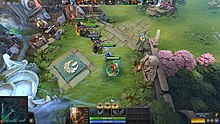Dota 2 is a 2013 multiplayer online battle arena (MOBA) video game by Valve. The game is a sequel to Defense of the Ancients (DotA), a community-created mod for Blizzard Entertainment‘s Warcraft III: Reign of Chaos. Dota 2 is played in matches between two teams of five players, with each team occupying and defending their own separate base on the map. Each of the ten players independently controls a powerful character known as a “hero” that all have unique abilities and differing styles of play. During a match players collect experience points and items for their heroes to defeat the opposing team’s heroes in player versus player combat. A team wins by being the first to destroy the other team’s “Ancient”, a large structure located within their base.
Development of Dota 2 began in 2009 when IceFrog, lead designer of Defense of the Ancients, was hired by Valve to design a modernized remake in the Source game engine. It was released for Windows, OS X, and Linux via the digital distribution platform Steam in July 2013, following a Windows-only open beta phase that began two years prior. The game is fully free-to-play with no heroes or any other gameplay element needing to be bought or otherwise unlocked. To maintain it, Valve supports the game as a service, selling loot boxes and a battle pass subscription system called Dota Plus that offer non-gameplay altering virtual goods in return, such as hero cosmetics and audio replacement packs. The game was ported to the Source 2 engine in 2015, making it the first game to use it.
Dota 2 has a large esports scene, with teams from around the world playing in various professional leagues and tournaments. Valve organizes the Dota Pro Circuit, which are a series of tournaments that award qualification points for earning direct invitations to The International, the game’s premier tournament held annually. Internationals feature a crowdfunded prize money system that has seen amounts in upwards of US$40 million, making Dota 2 the most lucrative esport. Media coverage of most tournaments is done by a selection of on-site staff who provide commentary and analysis for the ongoing matches similar to traditional sporting events. In addition to playing live to audiences in arenas and stadiums, broadcasts of them are also streamed over the internet and sometimes simulcast on television, with several million in viewership numbers.
Despite criticism going towards its steep learning curve and overall complexity, Dota 2 was praised for its rewarding gameplay, production quality, and faithfulness to its predecessor, with many considering it to be one of the greatest video games of all time. It has been one of the most played games on Steam since its release, with over a million concurrent players at its peak. The popularity of the game has led to merchandise and media adaptations, including comic books and an anime series, as well as promotional tie-ins to other games and media. The game allows for the community to create their own gamemodes, maps, and cosmetics, which are uploaded to the Steam Workshop. Two spinoff games, Artifact and Dota Underlords, were released by Valve. Dota 2 has been used in machine learning experiments, with a team of bots known as the OpenAI Five showing the capability to defeat professional players.
Dota 2 is a multiplayer online battle arena (MOBA) video game in which two teams of five players compete to destroy a large structure defended by the opposing team known as the “Ancient” whilst defending their own.[1][2] As in Defense of the Ancients, the game is controlled using standard real-time strategy controls, and is presented on a single map in a three-dimensional isometric perspective.[1][3] Ten players each control one of the game’s 124 playable characters, known as “heroes”, with each having their own design, strengths, and weaknesses.[1][2][4] Heroes are divided into two primary roles, known as the core and support.[5][6]

Cores, which are also called carries, begin each match as weak and vulnerable, but are able to become more powerful later in the game, thus becoming able to “carry” their team to victory.[5][7] Supports generally lack abilities that deal heavy damage, instead having ones with more functionality and utility that provide assistance for their cores, such as providing healing and other buffs.[5][6][8] Players select their hero during a pre-game drafting phase, where they can discuss potential strategies and hero matchups with their teammates.[2][5][6] Heroes are removed from the drafting pool and become unavailable for all other players once one is selected, and can not be changed once the drafting phase is over. All heroes have a basic attack in addition to powerful abilities, which are the primary method of fighting. Each hero has at least four of them, all of which are unique.[3][8] Heroes begin each game with an experience level of one, only having access to one of their abilities, but are able to level up and become more powerful during the course of the game, up to a maximum level of 30.[2][5] Whenever a hero gains an experience level, the player is able to unlock another of their abilities or improve one already learned.[2][5] The most powerful ability for each hero is known as their “ultimate”, which requires them to have an experience level of six in order to use.[6]
In order to prevent abilities from being overused, a magic system is featured in the game. Activating an ability costs a hero some of their “mana points“, which slowly regenerates over time.[3][9] Using an ability will also cause it to enter a cooldown period, in which the ability can not be used again until a timer resets. All heroes have three attributes: strength, intelligence, and agility, which affect health points, mana points, and attack speed, respectively.[5] Each hero has a primary attribute which adds to their basic non-ability damage output and other minor buffs—with four attributes including Universal, which rewards extra damage for attribute points.[5][10][11] Heroes have an ability augmentation system known as the “Talent Tree”, which allow players more choices on how to develop their hero.[5][6] If a hero runs out of health points and dies, they are removed from active play until a timer counts down to zero, where they are respawned in their base with only some gold lost.[12]
The two teams—known as the Radiant and Dire—occupy fortified bases in opposite corners of the map, which is divided in half by a crossable river and connected by three paths, which are referred to as “lanes”.[1][2] The lanes are guarded by defensive towers that attack any opposing unit who gets within its line of sight.[2] A small group of weak computer-controlled creatures called “creeps” travel predefined paths along the lanes and attempt to attack any opposing heroes, creeps, and buildings in their way.[2][6][12] Creeps periodically spawn throughout the game in groups from two buildings, called the “barracks”, that exist in each lane and are located within the team’s bases.[2][6][13] The map is permanently covered for both teams in fog of war, which prevents a team from seeing the opposing team’s heroes and creeps if they are not directly in sight of themselves or an allied unit. The map features a day-night cycle, with some hero abilities and other game mechanics being altered depending on the time of the cycle.[5] Present on the map are “neutral creeps” that are hostile to both teams, and reside in marked locations on the map known as “camps”. Camps are located in the area between the lanes known as the “jungle”, which both sides of the map have.[6][14]
Neutral creeps do not attack unless provoked, and respawn over time if killed. The most powerful neutral creep is named “Roshan”, who is a unique boss that may be defeated by either team to obtain special items, such as one that allows a one-time resurrection if the hero that holds it is killed.[2][6][15] Roshan will respawn around ten minutes after being killed, and becomes progressively harder to kill as the match progresses over time.[15] Runes, which are special items that spawn in set positions on the map every few minutes, offer heroes temporary, but powerful power-ups when collected, such as double damage and invisibility.[5][6]
In addition to having abilities becoming stronger during the game, players are able to buy items from set locations on the map called shops that provide their own special abilities.[2][6][15][16] Items are not limited to specific heroes, and can be bought by anyone. In order to obtain an item, players must be able to afford it with gold at shops located on the map, which is primarily obtained by killing enemy heroes, destroying enemy structures, and killing creeps, with the latter being an act called “farming“.[2][5][12] Only the hero that lands the killing blow on a creep obtains gold from it, an act called “last hitting“, but all allies receive a share of gold when an enemy hero dies close to them.[3][12] Players are able to “deny” allied units and structures by last hitting them, which then prevents their opponents from getting full experience from them.[12][15] Gold can not be shared between teammates, with each player having their own independent stash. Players receive a continuous, but small stream of gold over the course of a match.[5][17]
Dota 2 features multiple game types which mainly alter the way hero selection is handled; examples include “All Pick”, which offer no restrictions on hero selection, “All Random”, which randomly assigns a hero for each player, “Captain’s Mode”, where a single player on each team selects heroes for their entire team and is primarily used for professional play, and “Turbo”, an expedited version of All Pick featuring increased gold and experience gain, weaker towers, and faster respawn times.[18][19][20] Matches usually last around 30 minutes to an hour, although they can last forever as long as both Ancients remain standing.[6][21] In Captain’s Mode games, an additional “GG” forfeit feature is available to end games early.[22] Dota 2 occasionally features limited-time events that present players with alternative game modes that do not follow the game’s standard rules.[23] Some of these included the Halloween-themed Diretide event,[24] the Christmas-themed Frostivus event,[25] and the New Bloom Festival, which celebrated the coming of spring.[26] Other special game modes have been created by Valve, including a ten-versus-ten mode,[27] a Halloween-themed capture point mode “Colosseum”,[28] a combat arena mode “Overthrow”,[29] “Siltbreaker”, a story-driven cooperative campaign mode,[30] and “The Underhollow”, a battle royale mode.[31]
The move to the Source 2 engine in 2015 added the “Arcade” feature, which allows for community-created game modes, with the more popular ones having dedicated server hosting by Valve.[32][33] One popular example, known as Dota Auto Chess, had over seven million in-game subscribers by April 2019.[34][35][36] Owing to its popularity, Valve met with the mod’s developers, the Chinese-based Drodo Studio, to discuss directly collaborating on a standalone version. However, the two companies were unable to come to an agreement, with them both stating that it was in their best interest to develop their own separate games.[37] Valve’s version, Dota Underlords, was released in February 2020 and continued to use the Dota setting,[38] while Drodo’s game, Auto Chess, was developed using no Dota 2 assets.[39][40]
